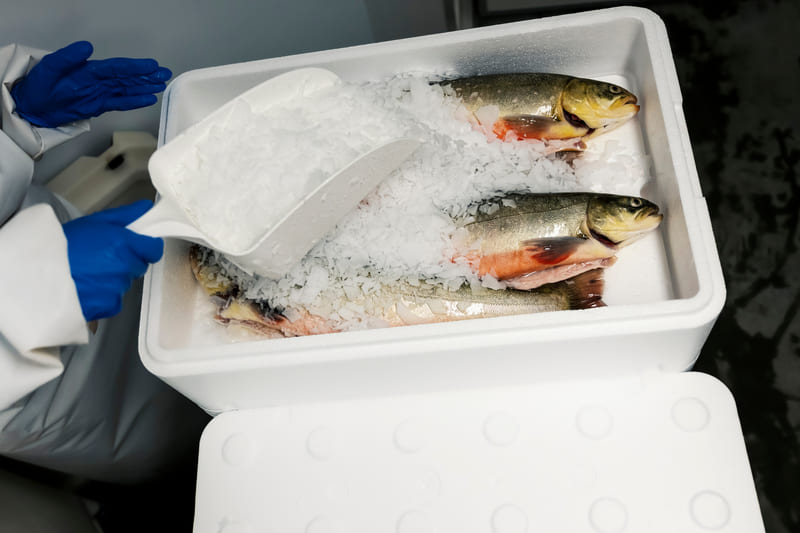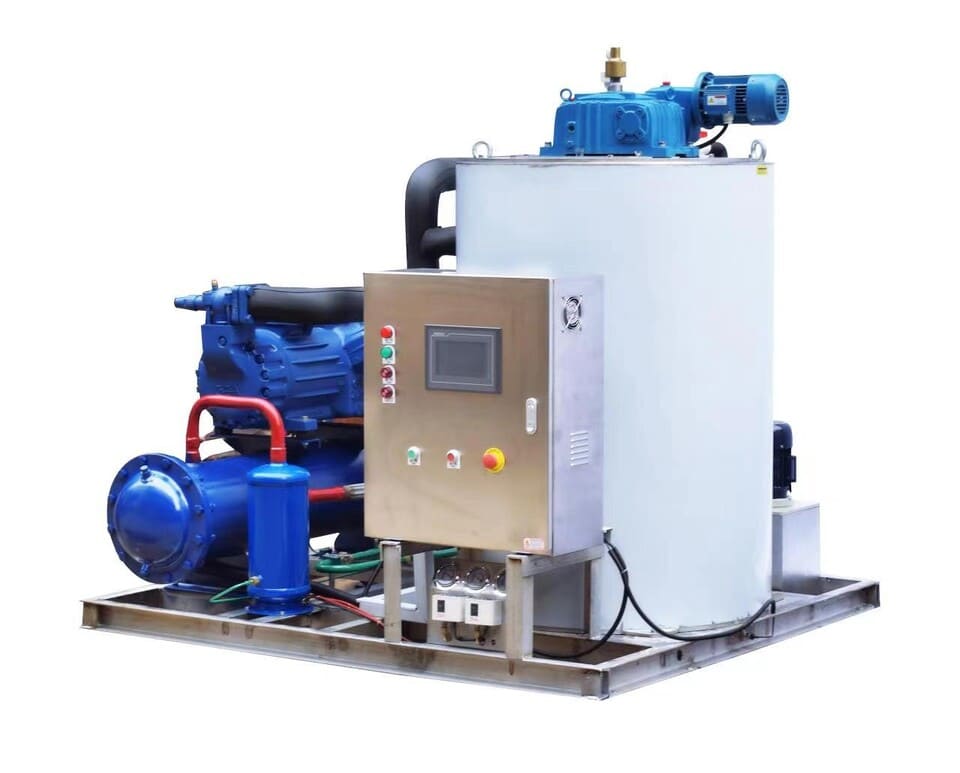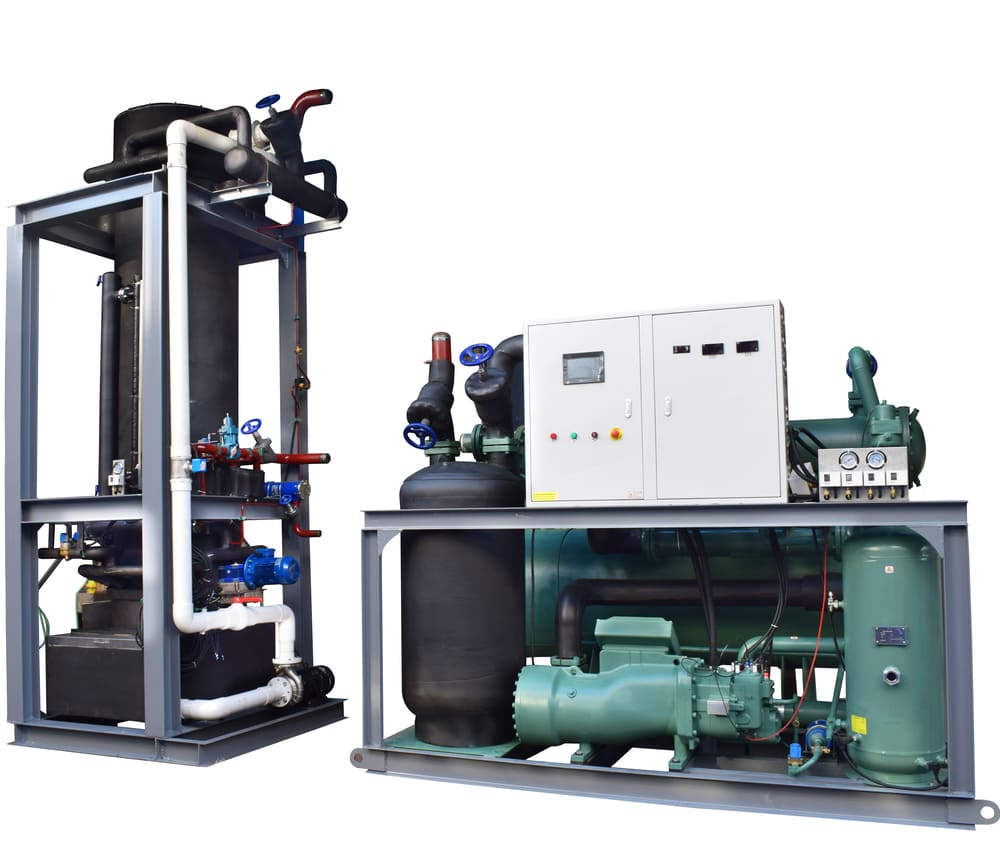Welcome to our guide on picking between a flake ice machine and a tube ice maker, where we’ll analyze the significant elements that should shape your choice. As an industry professional, you understand the importance of selecting the right commercial ice machines for your business applications, which may include fishery, seafood distribution, chilled and frozen meat import/export, or food processing plants.
In this comprehensive guide, we will delve into the characteristics of both flake ice machines and tube ice machines as well as discuss various aspects affecting their production levels. You’ll gain insights into how water temperature influences production efficiency and learn about heat exchangers like System IV ChillTech.

Furthermore, our analysis extends to different types of commercial ice makers such as full cube vs half cube machines, tubular nugget vs flake machines, and crescent vs gourmet machines. We will also provide application examples across industries for fishery/seafood distributors using Flake Ices and chilled/frozen meat importers/exporters using Tube Ices.
Lastly in “The Ultimate Guide to Choosing Between a Flake Ice Machine and a Tube Ice Machine”, we’ll assess cost-saving potential & efficiency levels by examining factors affecting consumption rates while evaluating efficiency levels between these two types of ice-making equipment. This knowledge will empower you to make an informed choice based on specific business requirements after weighing the pros & cons related to each option.
Understanding Flake Ice and Tube Ice Machines
To make an informed decision, it is essential to understand the distinctions between flake ice machines and tube ice machines. In this part, we’ll explore the specific qualities, uses, and potential cost savings of both flake ice machines and tube ice machines so you can make an educated choice.
Characteristics of Flake Ice Machines
Flake ice machines produce thin layers of irregularly shaped flakes that are soft yet relatively dry. These qualities allow them to cool products quickly while maintaining a high degree of contact with the surface area. This makes flake ice ideal for preserving perishable items like fish or meat by providing rapid cooling without causing damage due to freezing temperatures.
Characteristics of Tube Ice Machines
In contrast, tube ice machines create cylindrical-shaped nuggets with a hollow center. The structure allows these ices to last longer than other types as they melt slowly while still offering efficient cooling properties. This makes tube ice suitable for industries requiring extended periods of refrigeration during transportation processes or storage purposes.
To sum up, both flake and tube ice machines serve different purposes depending on your specific industry requirements. However, understanding their individual features will help you narrow down which type best suits your needs in terms of application efficiency levels:
- Flake Ice: Rapid cooling capacity and high surface area contact – Ideal for preserving perishables (e.g., fishery/seafood distributors)
- Tube Ice: Lasting cooling effect and slow melting rate – Suitable for long-term refrigeration (e.g., chilled/frozen meat importers/exporters)
Now that you have a better understanding of the differences between flake and tube ice machines, let’s explore how factors like water temperature can impact their production levels in the next section.
Flake ice machines and tube ice machines are two important components of any commercial or industrial refrigeration system. Making a knowledgeable choice when selecting the right machine for your requirements is key to ensuring optimal performance. Moving on to Factors Affecting Production Levels, it is essential to consider how water temperature impacts production efficiency as well as using heat exchangers like System IV ChillTech in order to maximize output levels.
Choosing the right ice machine for your business is important. Flake ice machines are ideal for preserving perishables due to their rapid cooling capacity and high surface area contact, while tube ice machines are suitable for long-term refrigeration with a lasting cooling effect and slow melting rate. Understanding the differences between these two types of machines will help you make an informed decision based on your specific industry requirements.
Factors Affecting Production Levels
When considering your ice machine’s efficiency, there are a few elements to take into account that may not be immediately visible. One crucial factor that can significantly impact production levels is water temperature. But don’t worry – we’ve got some cool solutions (pun intended) to help you maintain optimal temperatures for maximum output.
Importance of Water Temperature in Production Efficiency
The water temperature plays a vital role in determining how much ice your flake or tube ice machine can produce. Higher water temperatures result in slower freezing and decreased production efficiency, while lower temperatures enable faster ice-making. On the other hand, colder water allows for quicker freezing and increased efficiency.
- Ideal Temperature Range: For most commercial-grade ice makers like those from Hiceay, an ideal incoming water temperature range lies between 45°F (7°C) and 90°F (32°C).
- Potential Issues: If your business operates in an area with fluctuating or extreme temperatures throughout the year, maintaining this optimal range may prove challenging without additional measures.
Using Heat Exchangers for Consistent Performance
To ensure consistent performance regardless of external conditions, consider investing in a heat exchanger system. This innovative technology works by transferring excess heat from incoming water into outgoing wastewater before entering your commercial ice machine equipment. As a result:
- Your machine can maintain optimal water temperatures, leading to increased production levels and efficiency.
- Energy consumption is reduced as the machine doesn’t have to work as hard to cool down warm water, ultimately saving you money on utility bills.
In a nutshell, understanding how factors like water temperature can impact your ice machine’s performance will help you make informed decisions when selecting equipment and accessories. So go ahead – stay cool and keep those production levels high.
It is essential to understand the factors affecting production levels in order to make an informed decision when choosing a commercial ice machine. The next heading will focus on the types of commercial ice makers and their differences.
Maintaining optimal water temperature is crucial for maximum output and energy efficiency in commercial-grade ice makers. An ideal incoming water temperature range lies between 45°F (7°C) and 90°F (32°C), but heat exchanger systems can help maintain consistent performance regardless of external conditions, leading to increased production levels and reduced energy consumption.
Types of Commercial Ice Makers
Before diving into the nitty-gritty details of flake ice machines and tube ice machines, it’s essential to familiarize yourself with various types of commercial-grade ice makers available in today’s market. This will help you narrow down your choices effectively based on their unique purposes. Let’s explore some popular options:
Full Cube vs Half Cube Ice Machines
Full-cube ice machines produce large, slow-melting cubes that are perfect for cocktails or other beverages where dilution is undesirable. On the flip side, half-cube ice machines create smaller cubes that chill drinks quickly but may melt faster than full cubes.
Tubular Nugget vs Flake Ice Machines
Tubular nugget ice machines, also known as a pellet or chewable ice makers, generate soft and porous nuggets ideal for smoothies and blended drinks. In contrast, flake ice machines, like those from HICEAY.COM, produce thin flakes suitable for seafood displays or rapid cooling applications.
Crescent vs Gourmet Ice Machines
If you’re looking to elevate your beverage presentation game, consider a crescent ice machine, which creates unique, curved ice pieces that add visual appeal to drinks. For an even more sophisticated touch, gourmet ice machines produce crystal-clear, slow-melting cubes or spheres that enhance the appearance and taste of high-end cocktails.
Now that you have a better understanding of the different types of commercial ice makers available, let’s dive deeper into flake and tube ice machines to help you make an informed decision for your business needs.
The types of commercial ice makers available on the market today can range from full cubes to half cubes, tubular nuggets, and flake ice. It is essential to comprehend which type of machine will provide the most satisfactory outcome for your particular requirements.
Applications Across Industries
Selecting the perfect ice machine for your enterprise is critical to ensure maximum productivity and efficiency. To make an informed decision, it’s essential to understand how different types of ice machines serve various industries. In this section, we’ll explore some common applications for flake and tube ice machines in the fishery/seafood distribution and chilled/frozen meat import/export sectors.
Application examples for fishery/seafood distributors using Flake Ice
Flake ice machines are a popular choice among fisheries and seafood distributors due to their unique characteristics. The thin, flat flakes provide rapid cooling while preserving freshness without damaging delicate products like fish or shellfish. Some typical applications include:
- Fish storage: Flake ice maintains low temperatures effectively, ensuring that fresh catch remains at its peak quality during transport or storage.
- Aquaculture: Maintaining proper water temperature is vital in aquaculture facilities; flake ice can help regulate these conditions efficiently.
- Seafood processing plants: From filleting to packaging, flake ice plays a significant role in maintaining hygiene standards by keeping work surfaces cool throughout production processes.

Application examples for chilled/frozen meat importers/exporters using Tube Ice
In contrast with flake ice machines, tube ice machines produce cylindrical nuggets that offer longer-lasting cooling capabilities – making them ideal choices within the chilled/frozen meat industry sector. Here are some application examples:
- Cold chain logistics: Tube ice is perfect for maintaining low temperatures during transportation, ensuring that perishable goods like meat and poultry remain fresh throughout transit.
- Meat processing plants: Tube ice can be used to cool down carcasses after slaughter, helping maintain product quality while preventing bacterial growth.
- Supermarkets & retail stores: Tube Ice offers a visually appealing way of displaying chilled meats in-store, keeping them at optimal temperature levels without compromising on presentation.
By understanding the unique requirements of your industry sector and the specific applications for each type of ice machine, you’ll be better equipped to make an informed decision when choosing between flake or tube ice machines for your business needs.
Applications across industries are an important factor to consider when choosing between a flake ice machine and a tube ice machine. By assessing the cost-saving potential and efficiency levels, you can make sure that your business is getting the most out of its investment in an ice machine.
Choosing the right ice machine for your business is crucial. Flake ice machines are ideal for fisheries and seafood distributors, while tube ice machines are perfect for chilled/frozen meat importers/exporters. Understanding the unique requirements of your industry sector will help you make an informed decision when choosing between flake or tube ice machines.
Making the Right Choice for Your Business
When it comes to investing in a commercial-grade ice machine, understanding your unique business requirements is crucial. To make an informed decision between a flake ice machine and a tube ice machine, consider the industry sector you serve, the characteristics of each type, common applications, and cost-saving potentials.
Assessing Specific Business Requirements
To begin with, evaluate your daily operations and identify what kind of cooling solutions would best suit your needs. For instance:
- If you’re in the fishery or seafood distribution business where rapid cooling is essential to preserve freshness, flake ice machines might be more suitable.
- In contrast, if you deal with chilled or frozen meat import/export that requires longer-lasting cooling during transportation processes without melting quickly – tube-shaped nugget ice from tube ice machines could be ideal.
Weighing Pros and Cons of Flake Ice Machine vs Tube Ice Machine
Beyond specific application requirements within your industry sector:
- Analyze consumption rates/efficiency levels by comparing how much energy each type consumes per unit produced – this will give insight into their respective cost-saving potential over time.
- Evaluate other factors like maintenance costs associated with these ice makers – some may require more frequent servicing than others due to design differences which can impact overall expenses long-term (e.g., self-cleaning features).
- Lastly but importantly; take note of any additional benefits offered by certain models such as warranty coverage/support services provided directly by the manufacturer – these can prove invaluable when faced with unexpected issues down the line.
Considering all the components can assist you in making a choice that guarantees efficient performance and success during regular usage, while also providing maximum return on investment over time. Happy ice-making.
When choosing between a flake ice machine and a tube ice machine for your business, it’s important to assess specific requirements such as industry sector and cooling needs. It’s also essential to weigh the pros and cons of each type, including energy consumption, maintenance costs, and additional benefits offered by certain models. By considering all these factors, you can make an informed decision that ensures optimal performance while maximizing return on investment over time.
FAQs in Relation to The Ultimate Guide to Choosing Between a Flake Ice Machine and a Tube Ice Machine
What are the differences between a flake ice machine and a cube ice machine?
Cube ice machines create solid cubes in various shapes like full, half, crescent, or gourmet. Flake ice is ideal for seafood display and processing while cube ice is best suited for beverages.
What are the advantages of flake ice?
The main advantages of flake ice include rapid cooling due to its large surface area, easy moldability around products, reduced product damage as it’s softer than other types of ice, and efficient melting which reduces water waste.
What is the most efficient ice cube shape?
The most efficient ice cube shape depends on the application. For instance, half-cube or crescent-shaped cubes offer better liquid displacement in drinks while gourmet cubes melt slower, making them suitable for high-end cocktails. Evaluate your specific needs before choosing an ice machine.
How do I choose an Ice Machine?
To choose an appropriate Ice Machine, consider factors such as production capacity requirements based on daily usage volume, type of business (e.g., fishery/seafood distributor vs chilled/frozen meat importer/exporter), energy efficiency levels, available space, budget constraints, and maintenance requirements.
Conclusion
The Ultimate Guide to Choosing Between a Flake Ice Machine and a Tube Ice Machine provides valuable insights into the characteristics, production levels, types of commercial ice makers, applications across industries, cost-saving potential, efficiency levels, and making the right choice for your business. To make the best choice for your business, it is essential to evaluate the characteristics of both flake and tube ice machines, their production levels, cost-saving potential & efficiency levels.
By assessing specific business requirements and weighing the pros and cons between flake ice machines and tube ice machines, you can make an informed decision that will positively impact your bottom line. For more information on how we can help you choose the perfect commercial ice maker for your business, visit hiceay.com.




